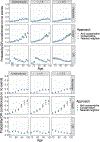Modeling semi-competing risks data as a longitudinal bivariate process
- PMID: 33908043
- PMCID: PMC11573714
- DOI: 10.1111/biom.13480
Modeling semi-competing risks data as a longitudinal bivariate process
Abstract
As individuals age, death is a competing risk for Alzheimer's disease (AD) but the reverse is not the case. As such, studies of AD can be placed within the semi-competing risks framework. Central to semi-competing risks, and in contrast to standard competing risks , is that one can learn about the dependence structure between the two events. To-date, however, most methods for semi-competing risks treat dependence as a nuisance and not a potential source of new clinical knowledge. We propose a novel regression-based framework that views the two time-to-event outcomes through the lens of a longitudinal bivariate process on a partition of the time scales of the two events. A key innovation of the framework is that dependence is represented in two distinct forms, local and global dependence, both of which have intuitive clinical interpretations. Estimation and inference are performed via penalized maximum likelihood, and can accommodate right censoring, left truncation, and time-varying covariates. An important consequence of the partitioning of the time scale is that an ambiguity regarding the specific form of the likelihood contribution may arise; a strategy for sensitivity analyses regarding this issue is described. The framework is then used to investigate the role of gender and having ≥1 apolipoprotein E (APOE) ε4 allele on the joint risk of AD and death using data from the Adult Changes in Thought study.
Keywords: alzheimer's disease; b-splines; discrete-time survival; longitudinal modeling; penalized maximum likelihood.
© 2021 The International Biometric Society.
Figures



Similar articles
-
Causal inference for semi-competing risks data.Biostatistics. 2022 Oct 14;23(4):1115-1132. doi: 10.1093/biostatistics/kxab049. Biostatistics. 2022. PMID: 34969069 Free PMC article.
-
Accelerated failure time models for semi-competing risks data in the presence of complex censoring.Biometrics. 2017 Dec;73(4):1401-1412. doi: 10.1111/biom.12696. Epub 2017 Apr 10. Biometrics. 2017. PMID: 28395116 Free PMC article.
-
Short leukocyte telomeres predict 25-year Alzheimer's disease incidence in non-APOE ε4-carriers.Alzheimers Res Ther. 2021 Jul 15;13(1):130. doi: 10.1186/s13195-021-00871-y. Alzheimers Res Ther. 2021. PMID: 34266503 Free PMC article.
-
Association of apolipoprotein E genetic variation in Alzheimer's disease in Indian population: a meta-analysis.Am J Alzheimers Dis Other Demen. 2014 Nov;29(7):575-82. doi: 10.1177/1533317514531443. Am J Alzheimers Dis Other Demen. 2014. PMID: 25551132 Free PMC article. Review.
-
Association between Apolipoprotein E Gene Polymorphism and Alzheimer's Disease in an Iranian Population: A Meta-Analysis.J Mol Neurosci. 2019 Dec;69(4):557-562. doi: 10.1007/s12031-019-01381-1. Epub 2019 Aug 23. J Mol Neurosci. 2019. PMID: 31444704 Review.
Cited by
-
Causal inference for semi-competing risks data.Biostatistics. 2022 Oct 14;23(4):1115-1132. doi: 10.1093/biostatistics/kxab049. Biostatistics. 2022. PMID: 34969069 Free PMC article.
References
-
- Alzheimer’s Association., (2018) 2018 Alzheimer’s disease facts and figures. Alzheimer’s & Dementia, 14, 367–429.
-
- Baumgart M, Snyder H, Carrillo M, Fazio S, Kim H and Johns H (2015) Summary of the evidence on modifiable risk factors for cognitive decline and dementia: a population-based perspective. Alzheimer’s & Dementia, 11, 718–726. - PubMed
-
- Carey V, Zeger S and Diggle P (1993) Modelling multivariate binary data with alternating logistic regressions. Biometrika, 80, 517–526.
-
- D’Agostino R, Lee M-L, Belanger A, Cupples L, Anderson K and Kannel W (1990) Relation of pooled logistic regression to time dependent Cox regression analysis: the Framingham heart study. Statistics in Medicine, 9, 1501–1515. - PubMed
-
- Egleston B, Scharfstein D, Freeman E and West S (2006) Causal inference for non-mortality outcomes in the presence of death. Biostatistics, 8, 526–545. - PubMed
Publication types
MeSH terms
Substances
Grants and funding
LinkOut - more resources
Full Text Sources
Other Literature Sources
Medical
Research Materials
Miscellaneous

